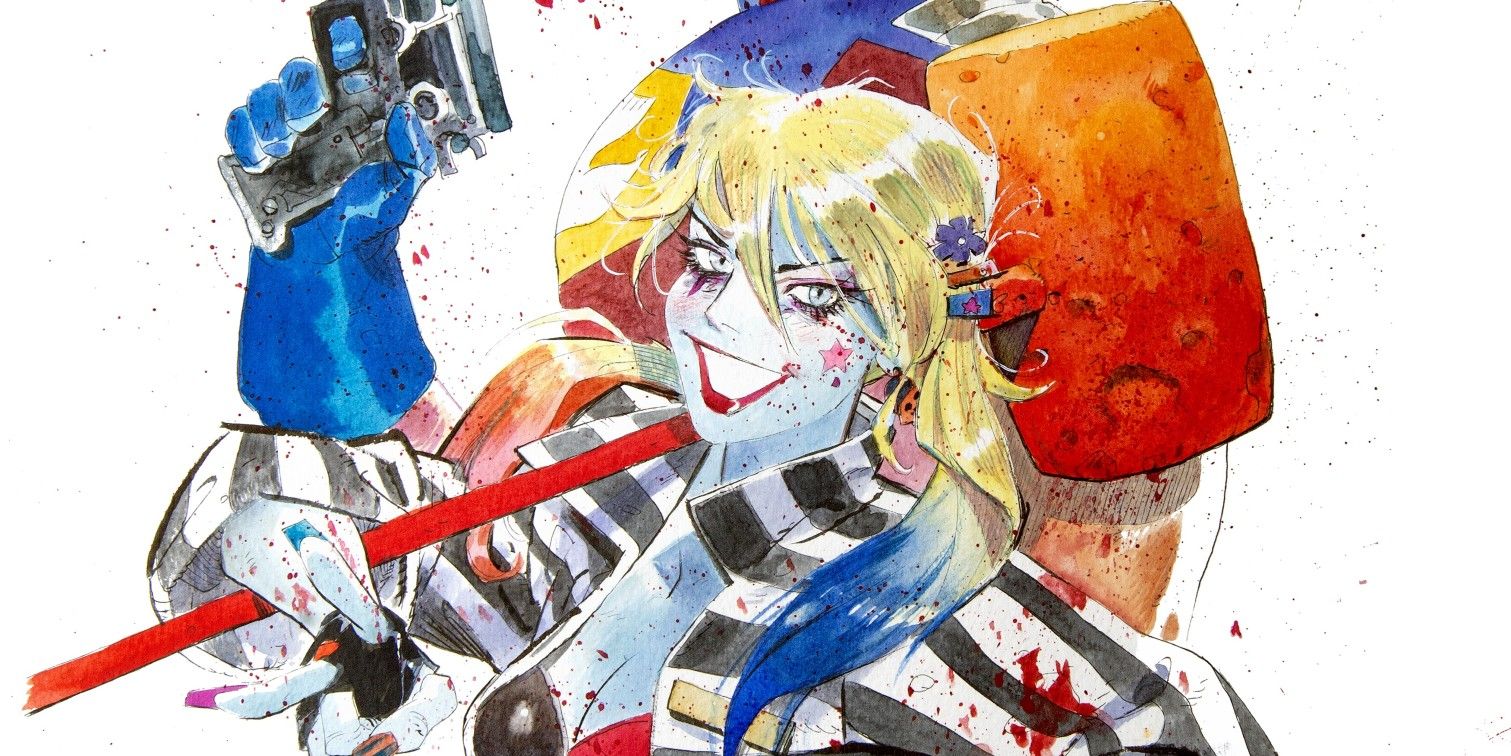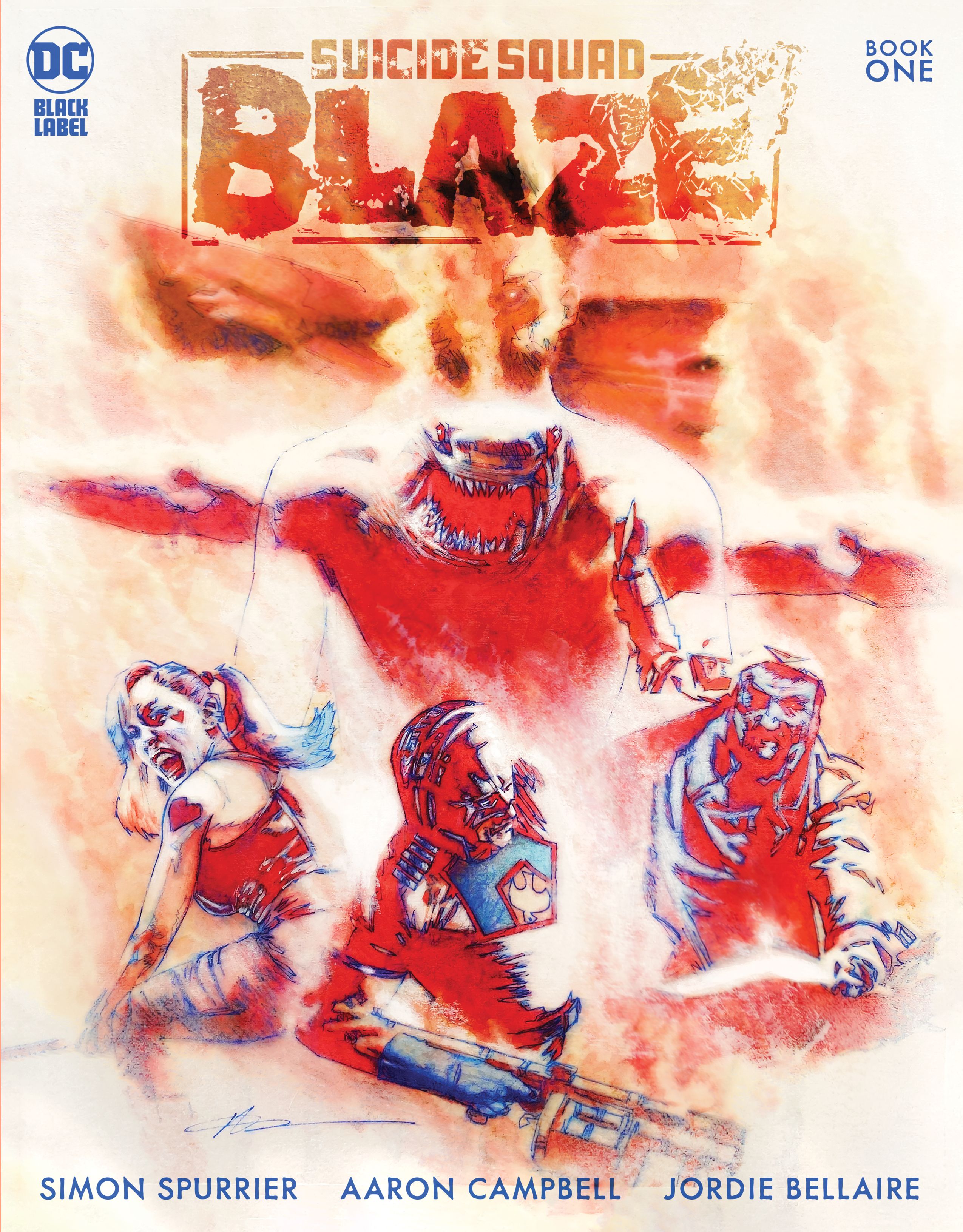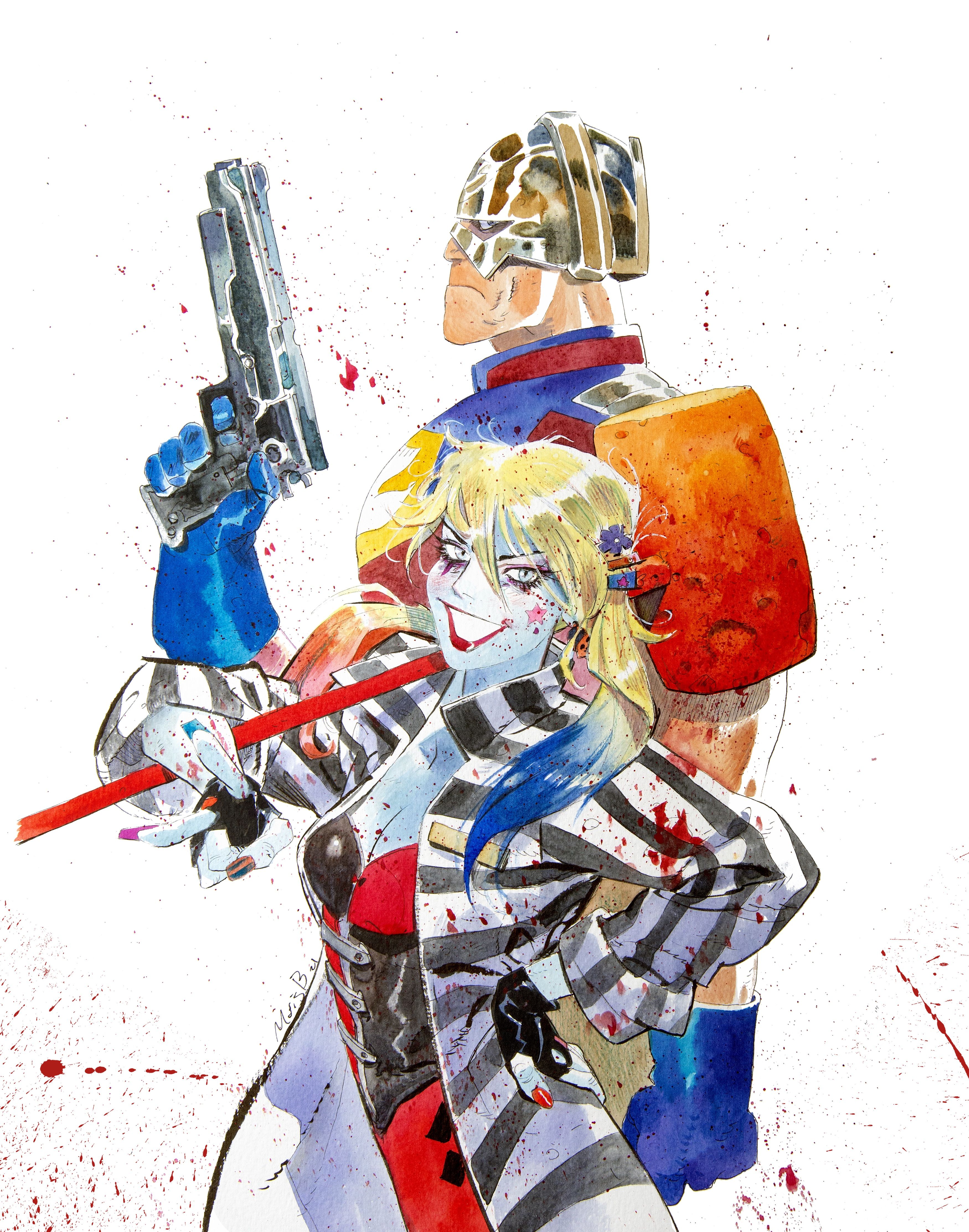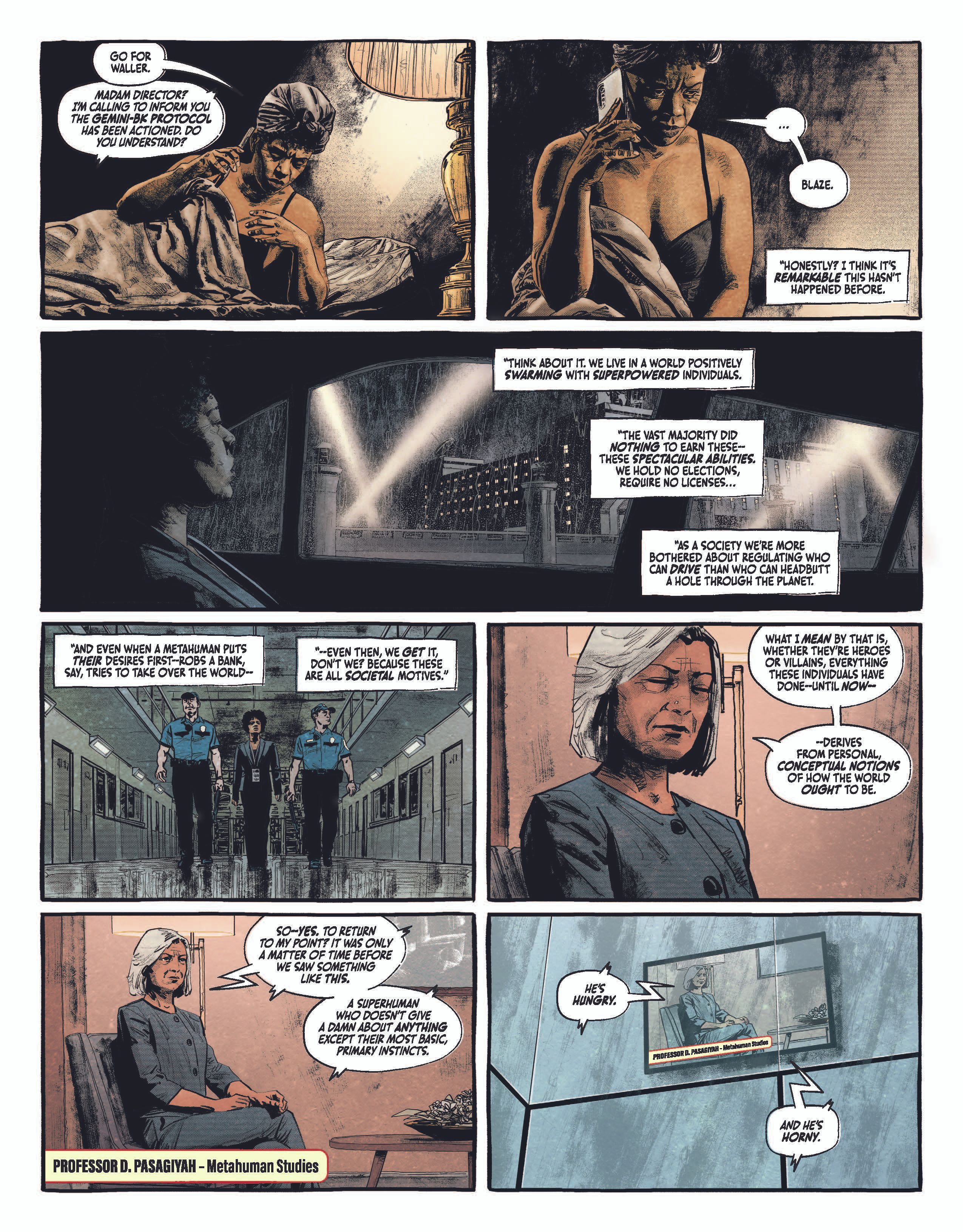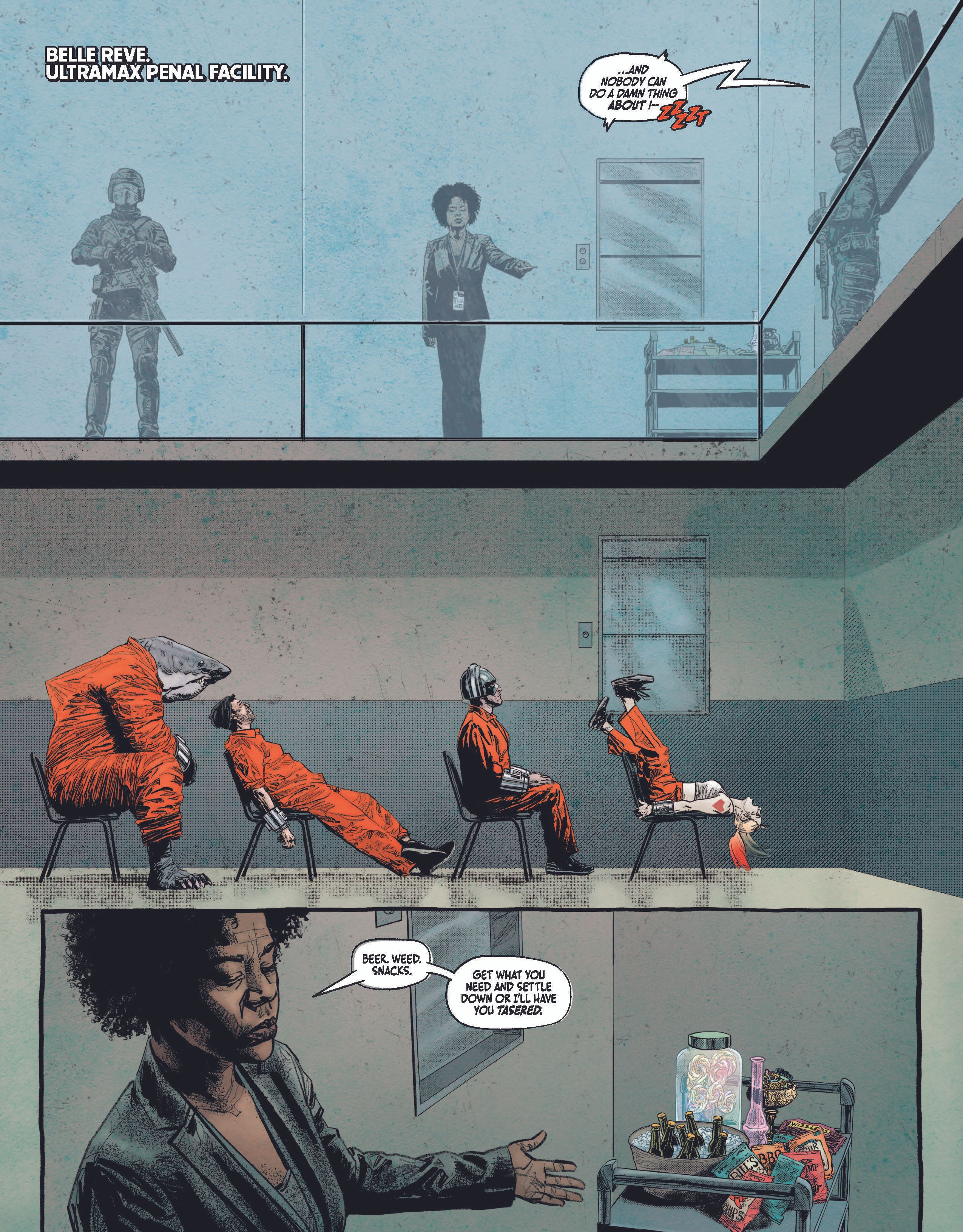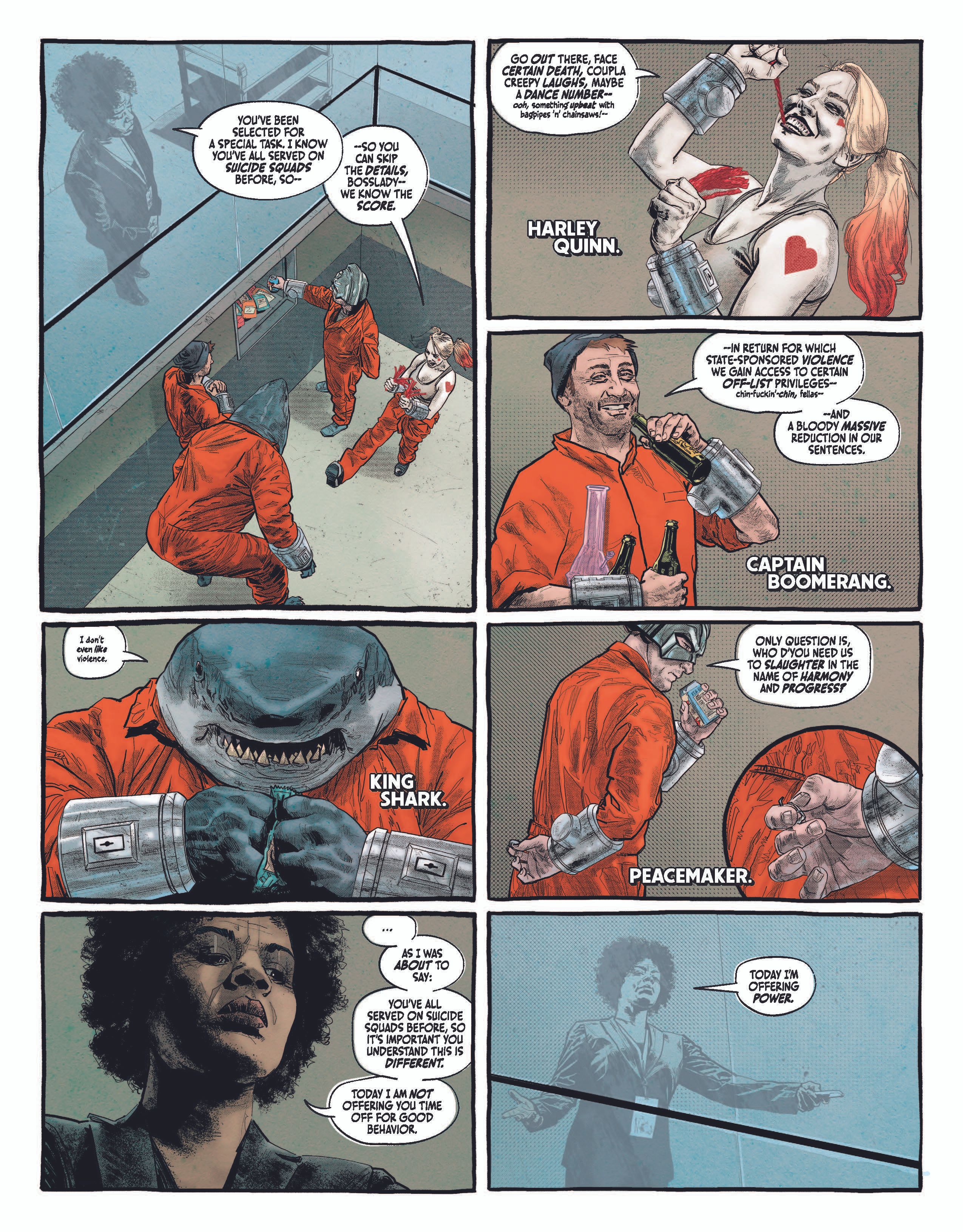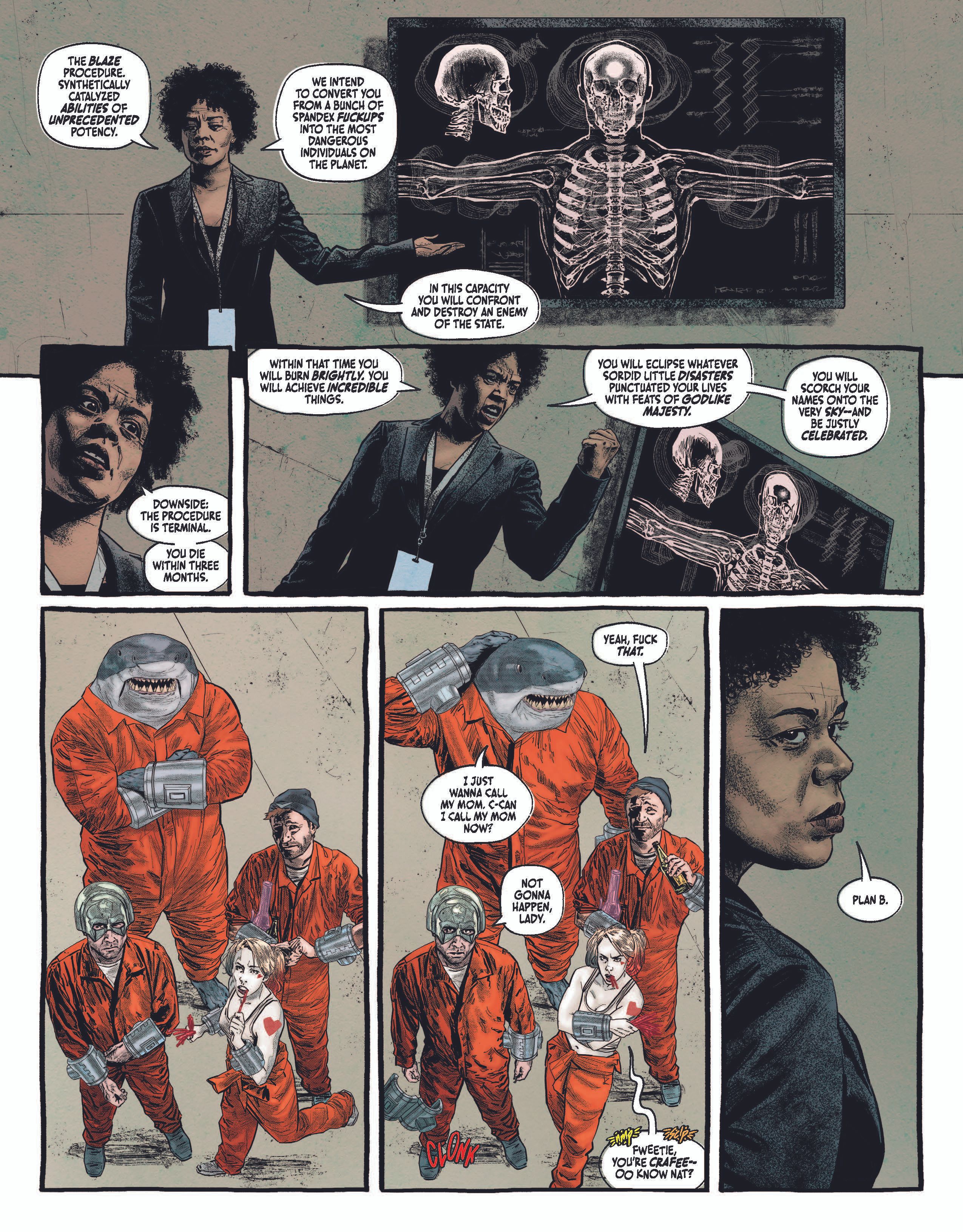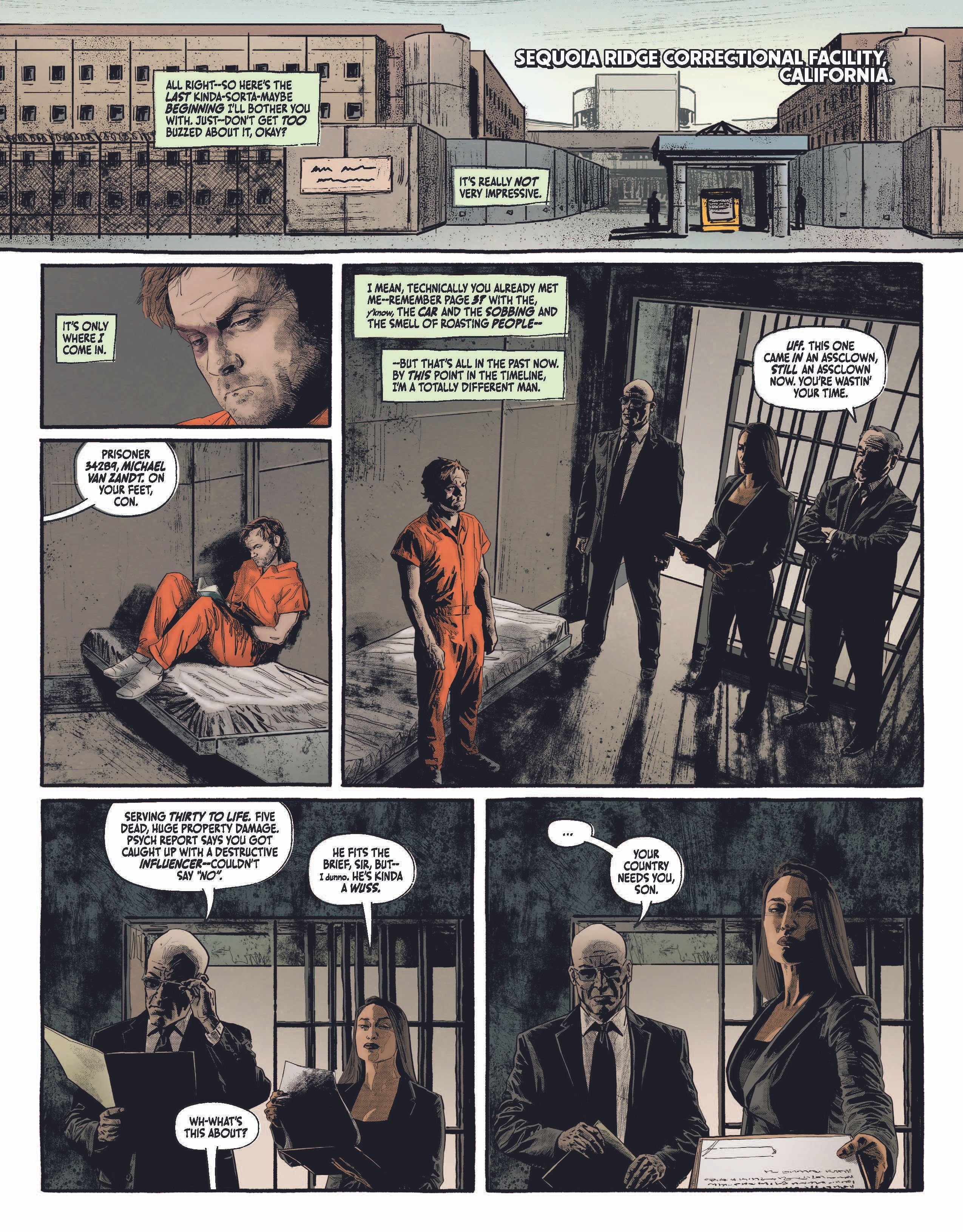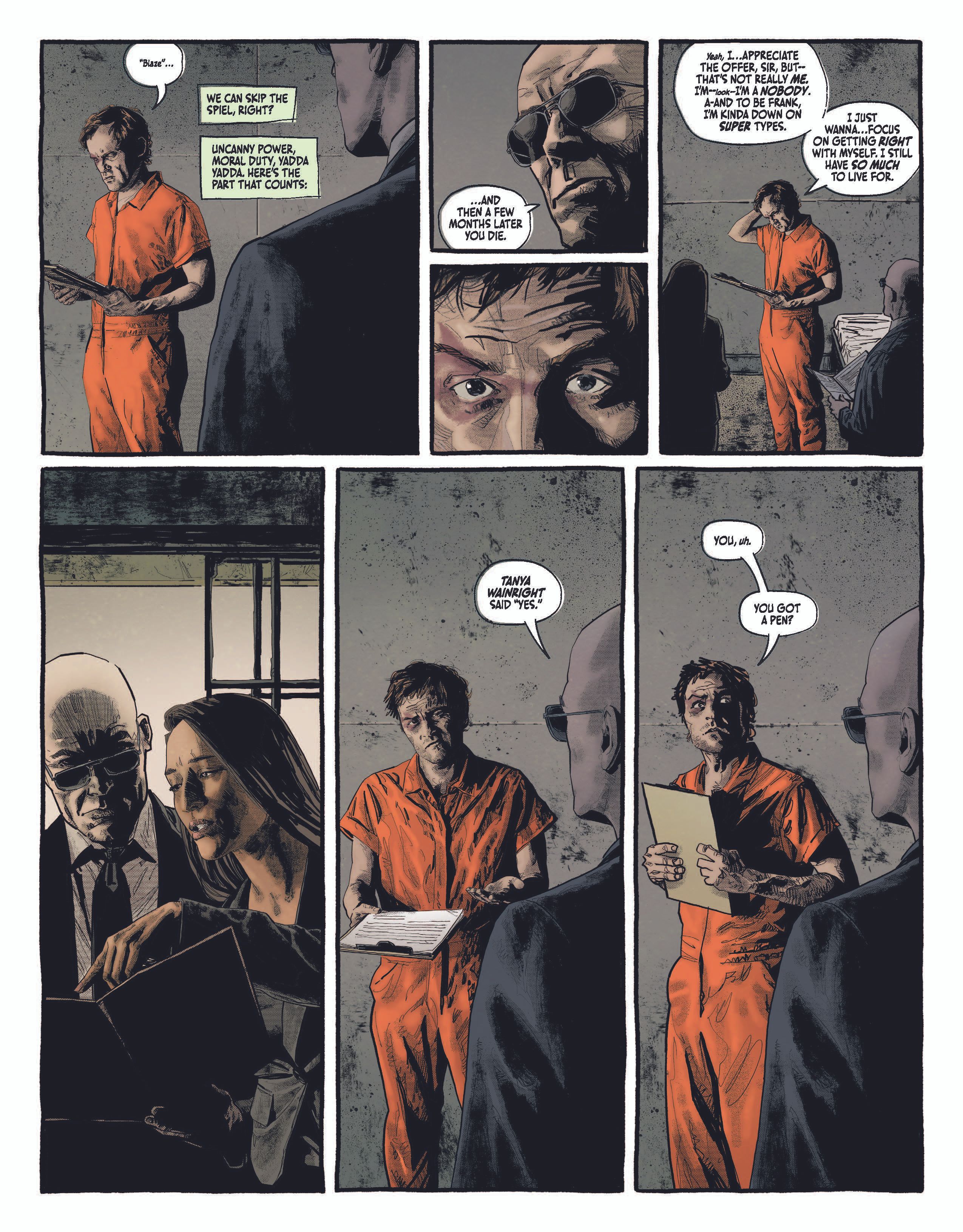After a critically acclaimed run on the DC Black Label series John Constantine: Hellblazer, the creative team reunites for a new Black Label comic book series focused on the Suicide Squad. Helmed by writer Si Spurrier and artist Aaron Campbell, along with returning Hellblazer collaborators -- editor Chris Conroy, colorist Jordie Bellaire, and letterer Aditya Bidikar -- the three-issue miniseries Suicide Squad: Blaze adds a twist to the misadventures of Task Force X. The next generation of recruits must bring down a mysterious monster on a global rampage. They receive their powers through gruesome experimentation, with their new abilities eventually burning them out and killing them in a matter of months.
In an exclusive interview with CBR, Spurrier and Campbell explained how Blaze elevates conventional genre constraints to bring horror and humor to Task Force X, putting the classic Suicide Squad in the role of unlikely mentors. Spurrier shared the origin behind Suicide Squad: Blaze's story, while Campbell revealed how the artwork visually and creatively pushed him further than any prior project. Also included with this interview is a sneak peek at preview artwork from Suicide Squad: Blaze #1 and its standard cover drawn by Campbell and colored by Bellaire, and the debut issue's variant cover illustrated by Matias Bergara.
How did the idea to introduce these antiheroes with a half-life for Suicide Squad: Blaze first come about?
Si Spurrier: It was a series of happy coincidences. We had done Hellblazer together and we learned, over the course of that, that we work together extremely well and enjoyed the collaboration. When that came to an end we asked Chris [Conroy], one of the editors at Black Label, what we could do next, and he suggested that the Suicide Squad might be a really cool book to get the Hellblazer treatment. That happened to play into a lot of ideas that we had already been toying with -- in particular the idea that if you posit a world where people really do have superpowers, there's a version of that world where it's aspirational and all about role models.
But there's also a version that's absolutely fucking terrifying, with people flying around able to do whatever they want and claiming to be the arbiters of truth and justice, even though nobody has elected them. We all know that the Suicide Squad characters that we know and love have survived hundreds of allegedly suicidal missions. We thought it would be really fun to introduce some new characters where the stakes are loose and the reader has no idea if these characters are going to survive. With this book being the way that it is, it's not a case of who might die but rather are any of them going to survive [laughs]? It's about adding that tension and doing it in a way that speaks quite loudly to the idea of what it is to be a superhuman and how frightening that can be to the superhuman themselves and the people around them.
You have a P.O.V. character with Michael van Zandt. How did the idea for him and his entry into this wicked, wicked world come about?
Spurrier: Michael is a very interesting character and, without causing too many massive spoilers, the central idea of Suicide Squad: Blaze is that if you ask people to accept a series of superpowers with the knowledge that it would kill them within several months, what sort of people would say, "Yes?" Those are our central characters and they're mentored in this story by the recognizable, A-list Suicide Squad characters we know. We've got Harley, King Shark, Peacemaker, and [Captain] Boomerang but we've also got these troubled, eccentric characters who know they're on a ticking clock. The delight of this story has been to examine what sort of people they are.
In the case of Mike, he's the one unexpected member of that group. He's not suicidal, reckless, or crazy: he thinks he has a good reason for being in this group but it's a pathetic, codependent, sad reason. That makes him an interesting character to me because when you start someone as pond slime, the only way is up. He has a really interesting character journey.
Aaron, you mentioned when the series was announced that you particularly enjoyed drawing King Shark. What is it about him that you enjoy illustrating and are there any other familiar characters you also enjoy drawing in action?
Aaron Campbell: King Shark is just a delight because he's so different from anything I've ever drawn before. Before comics, I was doing fantasy book covers and, even then, I wasn't really given an opportunity to draw monsters. I love Dungeons & Dragons. I run a game every week. This tickles that fancy, that fantastic quality and he's so big. I started to realize that even though he has those dead shark eyes and expressionless face, there's a lot of pathos you can put into a character like that just through their body language. He has such an interesting, big, lumbering oaf sort of quality to him and it's been fun to play with that.
Drawing Harley, Peacemaker, and Captain Boomerang is a lot of fun. [Boomerang] is a drunk and, in the back of my head, he's almost my John Constantine surrogate on some level because he has that broken-down quality to him and wears a trench coat as well. All four of those characters have allowed me to experiment with the full gamut of character traits: the exuberance of Harley, the stoic quality of Peacemaker, and what I was saying about Boomerang and King Shark.
As far as the rookies go, they fit right into my love of just drawing average people. I find the most interesting people to draw typically are normal people -- not beautiful, handsome, muscular slim [figures], but just people with physical faults and idiosyncrasies. I love that. I did this idea in Hellblazer: When we first started, John had just gotten out of the asylum and his head was shaved so, over those first six issues, I grew his hair out in each issue a little longer until he was John again. I'm doing some of the same things with these rookies. There's a character who has this awakening and she changes the way that she presents herself in Suicide Squad: Blaze #2 and the same thing with Mike. Mike starts to find himself maybe we can play with that a little bit and you'll notice there's a shift in how Mike looks between issues.
As these new recruits get their powers, there's a bit of body horror involved. How is it bringing that while keeping in line with the book's visuals and tone?
Spurrier: I think it's part of the heroic and villainous journey. We're very fond of saying that this is a horror story about horrible people [laughs]. It's quite nice to see them endure something extraordinary to achieve what, for many of them, is great ambition in achieving great power. For Mike, it's sort of an accident, and [he] stumbles into it for all the wrong reasons. As they're all lying there waiting for this procedure, none of them have asked what sort of superpowers they're likely to get. It's horrifying and as this is a horror story, any kind of horror is good.
Body horror works great in comics because we don't have the privilege of the jump scare so horror has to be a little bit smarter, very visual, and about unnerving your reader so that they do the hard work of horrifying themselves. To see these people who have agreed to undergo this terminal procedure scream their guts out as scientists poke and prod them felt right.
Campbell: As far as body horror goes, that's my bag. I've been doing body horror since Infidel. The rookie characters in this don't have costumes, they're in plain clothes, so in my mind, their power is their costume. When that's on display, that becomes their costume but also expresses the supernatural, existential weirdness behind the idea that's baked into the story that Si is trying to tell. That all plays a big role in how I started to conceive what these powers would end up looking like.
If doing horror in comics has its own challenges, so does doing humor in comics. While Hellblazer had its fair share of dark humor with Constantine's sardonic and cynical, how is it dialing that twisted sense of humor up to eleven with Suicide Squad: Blaze?
Spurrier: It's critical! You can't tell a story about literal suicide, mortality, and a cannibalistic superhuman preying on people all over the planet and a group of people essentially agreeing to kill themselves in order to stop it without becoming really, really miserable [laughs]. The only way to have your cake and eat it is to throw in buckets of really bleak gallows humor. We're lucky that the four existing Suicide Squad members are drenched in that background anyway.
Harley has that penchant for doing hilarious, slapsticky things in the process of being completely spontaneous and probably quite frightening if you met her in the real world [laughs]. Boomerang is just a pleasure, going in half-cocked, macho, and stupid. King Shark is a challenge because he's been played in so many ways over the years so you either take a stand and choose a particular version or find a way to oscillate and we've done the latter. We figured that, in essence, he's just a really nice boy and doesn't really like violence. He just really wants to talk to his mum and he's stuck in jail asking if he can call his mum and no one lets him call her and, since he's a shark, whenever he smells blood, the other side of him comes out.
Peacemaker is just joyous to write because he's like somebody that you get chatting with and think it's all fun and games as they say fantastic and absurd stuff and then you realize the eyes are dead, the smile is fixed and he believes every word he says [laughs]. He's coldly terrifying as a result. They are a joy to write because, despite being the perfect pit for humor, they're also the perfect pit for comedy and we've tried to emulate that with the new characters so they can sit in that paradigm as well.
After working together on Hellblazer, how do you creatively push yourselves and elevate each other with this collaboration?
Campbell: My whole idea for the [antagonist, the Predator] is based on a fan theory about Superman, which has never been canonized but I thought was a fun idea. A lot of people would solve the problem of [illustrating] the Predator by drawing him as a silhouette, keeping him silhouetted so you never really see him. That's what was written in the script: "I don't know how you're going to do it, we've got to see him but we can't see him!" [laughs] The fan theory goes that people can't recognize Superman is Clark Kent because he vibrates at this high frequency so when you see Superman he's just this vibrating blur. That's something you can't present in a static image easily so you just don't get it and that's kind of an absurd idea, but I think it's fun. Superman doesn't do that but what if our Predator does that and that was the foundation of the idea.
What I came up with was every time you see [the Predator], he's moving so chaotically that you can never quite pin him down. He's always in multiple places at the same time and it's uncertain whether he's moving at Flash-like speeds and you're just catching glimpses here and there or actually phasing in and out of time and space at different places. That doesn't really matter but I wanted to play with this idea of doing multiple exposures, blurs, and all this kind of distortion that I love to do. But every time he's on a panel, this page is going to take a while [laughs]. I pose all of this torment on myself, making my life harder on purpose.
What is something unique you hope to bring to the Suicide Squad with this story?
Spurrier: I think it's really wonderful to be able to take some really well-known characters and put them in a new genre position, specifically one of horror, and be delighted to discover that they fit like a glove. They work so well as characters and vehicles for horror. To tell a really great and spooky monster story which is a heartfelt, philosophical meditation on loss and dependency, and, at the same time, funny and has a lot of quite smart stuff to say about the mythology of superheroes. We couldn't have done that with any other IP than the Suicide Squad. It works like a dream.
Campbell: For me, it's a chance to stretch my artistic muscle. I'd never done a team book before, and I'll probably not choose to do a team book again because of how intense it is but it's been such an incredible challenge to engage with a type of story that I've never done before. I'm always up for a challenge and eager for that. There's stuff I'm doing in this book that I've never done before and with Suicide Squad: Blaze #2 even more so, it's just a joy. With Si, he sets me up to succeed. We've gotten to the point where he knows the kinds of imagery that's going to pique my interest and creative side.
Spurrier: It's so funny because if you started from a position of a critically acclaimed run on Hellblazer and then somebody suggested to you that you take all the vibes, things that worked, and ingredients and staple them all onto the Suicide Squad you'd think, "What the fuck are you talking about?! That's not going to work!" [laughs] But it kind of does!
Written by Si Spurrier and with artwork by Aaron Campbell, Suicide Squad: Blaze #1 goes on sale on Feb. 8 from DC Comics.

